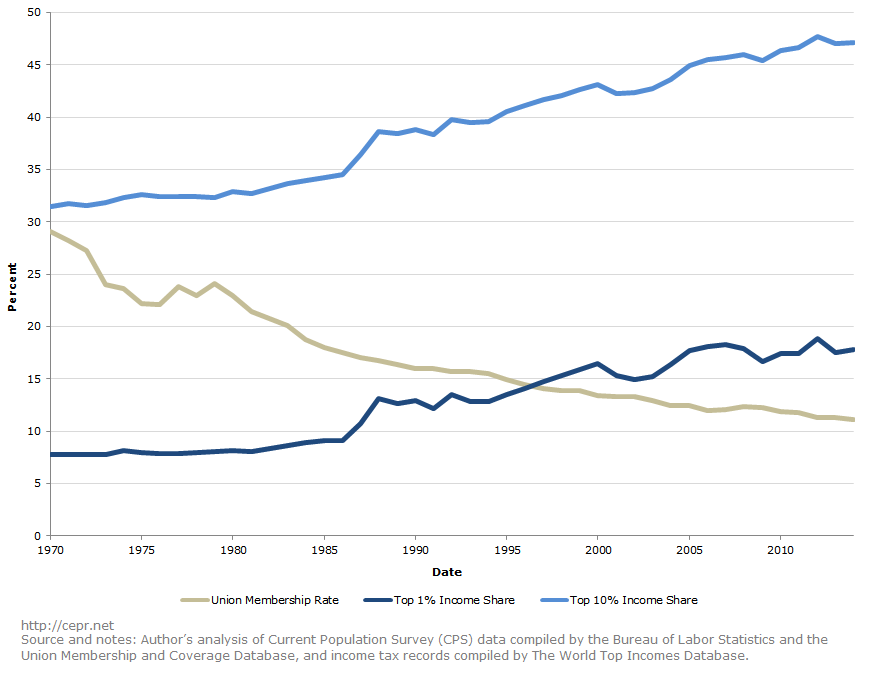Article
Fact-based, data-driven research and analysis to advance democratic debate on vital issues shaping people’s lives.
Center for Economic and Policy Research
1611 Connecticut Ave. NW
Suite 400
Washington, DC 20009
Tel: 202-293-5380
Fax: 202-588-1356
https://cepr.net
The union membership rate tracks the percentage of all workers who are members of a union. In 1955, the membership rate peaked at 35 percent. Union membership remained strong until the late 1960s. In 1970, the membership rate stood at 29.1 percent. Since then it has fallen steadily. The most recent data from the Bureau of Labor Statistics shows a nationwide membership rate of 11.1 percent. There have been a number of negative impacts that correlate with the decline in union density. One of the clearest is an increase in income inequality.

The graph above highlights the change over time of three variables; the union membership rate and the income shares of the top 1 percent and the top 10 percent. When examining income inequality we examine the share of income that the top 1 percent and top 10 percent of income earners receive. In 1970, one percent of the population received 7.8 percent of all income. That same year ten percent of the population received 31.5 percent of all income. As of 2014 one percent of the population received 17.9 percent of all income and ten percent of the population received 47.19 percent of all income, nearly half of all available income.
The decline in union membership largely coincides with this increase in income inequality. A study published in 2011 by the American Sociological Review found that the decline in union density since 1973 explained a third of the increase in wage inequality among men, and a fifth of the increased inequality among women.

The explanation for this trend is simple; unions have a positive impact on wages. Unionized workers have on average 20 percent higher wages than their non-union peers. The collective bargaining power of unions also benefits workers in non-unionized workplaces. According to an article published by the Economic Policy Institute, “a high school graduate whose workplace is not unionized but whose industry is 25 percent unionized is paid 5 percent more than similar workers in less unionized industries.” As union representation increases in an industry, all the workers in that industry benefit because employers must become more competitive, and make better offers, if they want to attract the quality of labor they need.
Unions have also played an important role in pushing for higher minimum wages. The states with higher union density (New York, California, Alaska, etc.) tend to be the states that have minimum wages that are higher than the federal minimum wage.
Unions have a positive impact on wages but specifically on the wages of the bottom 90 percent of wage earners. Between 1930 and 1970, when union membership was at its highest, the average income for the bottom 90 percent of wage earners increased by 242.8 percent (in real 2014 U.S. dollars). Since the decline in union membership income for this demographic has been nearly stagnated, while incomes for the top 10 percent have increased dramatically.
Without unions, the bottom 90 percent would lose much bargaining power and more income would inevitably find its way into fewer hands.